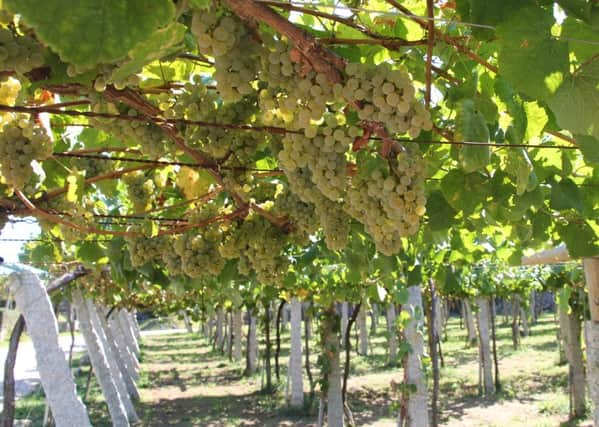Wine: Albariño - all the rage in Spain


If there is one grape variety that could knock Sauvignon Blanc and Pinot Grigio off the top of the best-selling charts, it is Albariño. This is such a friendly grape. It has light, delicate apricot and peachy notes, backed by a touch of lemongrass and mandarin orange peel with underlying lime freshness that makes it a delightful wine to drink, especially when the sun is out. What gives Albariño its own particular character is that it is perfectly good to drink on its own as an aperitif, but it can settle around whatever is on your plate, particularly fish, shellfish and salads, and at a push, chicken and lightly spiced Asian and Mexican dishes. It doesn’t dominate, but adds to the overall balance of a meal.
That is why Albariño is so very fashionable in the bars and restaurants of Madrid and Barcelona and it is increasingly cropping up on shelves and wine lists in the UK. The only thing getting in the way of this worldwide domination is that there simply isn’t enough of it.
Advertisement
Hide AdAdvertisement
Hide AdAlbariño’s main home is in Galicia, that remote part of north-west Spain which has the Atlantic on two sides. Just 30 years ago the region of Rías Baixas was delimited and since then it has gradually expanded as more vineyards are planted with this fabulous grape. Even so, there are only 4,000 hectares of Albariño in Rías Baixas (pronounce it – ree-ash bye-shass). Compare that with the 20,000 hectares of Sauvignon Blanc in New Zealand and it is easy to see why this grape is so elusive.
Vineyards are spread across five zones, from Salnés on the coast to Condado de Tea along the bank of the River Miño which forms the border with Portugal. Each region has its own characteristics, with vineyards close to the sea having more freshness and vibrancy, while inland areas have softer, rounder flavours.
The rain mainly arrives in winter and it sinks through the ground, so the vine roots follow the moisture and dig deep into the mineral-rich soil. Albariño grapes are ideally suited to the climate since they have thick skins that shake off the water, and are packed with flavours that add to the character of the wine.
This hilly, beautiful verdant landscape has been divided and subdivided over the generations and the region is now a patchwork of small, family-owned vineyards. A great many owners work their vineyards and take their crop to the local co-operative to be made into wine.
Advertisement
Hide AdAdvertisement
Hide AdThere are some bigger estates in the region and these are the wines we are likely to see on our shelves.
Just over the river from Rías Baixas is the Vinho Verde region of Portugal and Albariño – now renamed Alvarinho – is a major component in these wines. Despite the closeness of these regions, there is a distinct difference between the two wines. Vinho Verde seems to have an edge more citrus fruit, making it brighter and leaner, but it is still a fabulous wine to accompany shellfish.
Other wine regions around the world have noted the success of the Albariño grape and many are busy planting it in the hope of catching up with its popularity. New Zealand has a head start and there are several producers now growing enough Albariño to sell over here.
Australia set off with enthusiasm to plant Albariño but encountered a devastating problem when it was discovered that a number of imported vines carried the wrong labels and have since been identified as the less aromatic and more structured Savagnin Blanc.
Advertisement
Hide AdAdvertisement
Hide AdWhile the Aussies go back to the drawing board, New Zealand, California and South Africa are gradually building enthusiasm. I tasted a first-vintage Albariño from just a quarter hectare site at Newton Johnson in Hemel-en-Aarde in South Africa earlier this year. It had all the right characters with a delightful fresh flavour and so another hectare of Albariño vines is being planted right now.
If you are planning a fish barbecue, a salad supper or just want to try the best flavours of this delicious grape, here are my favourites. This is one wine where you don’t have to find the latest vintage. It gradually builds flavours over one to three years, so explore and enjoy it as it ages.
Morrisons The Best Albariño 2015, Galicia, Spain, £8: Light peachy, notes with a delicious crisp backbone. A bargain.
Caixas Albariño 2015, Martin Codax, Rías Baixas, Majestic, £8.49 on a mix- six deal: Light, simple, refreshing flavours with apricot and honeysuckle notes.
Advertisement
Hide AdAdvertisement
Hide AdYou and Me Albariño 2016, Rías Baixas, Ocado, £11.99: A fresher, cleaner, brighter style than most, with linear lime fruit and soft aromatic peachy notes.
Left Field Albariño 2015, Te Awa, New Zealand, Field & Fawcett, £13.20: Riper flavours in this New Zealand version of the grape, with positive peach notes, melon and lime freshness.
Pazo de Señorans 2014, Rías Baixas, Latitude, Leeds, £17.99: Owned by the Bueno family, this is seen as one of the best Rías Baixas estates making particularly smooth and elegant wines. Think orange zest, white flowers and nectarines.
Palacio de Fefiñanes Albariño 2015, Rías Baixas, Martinez, Ilkley, £19.49: Aromatic with apricot and mandarin zest notes with a silky rounded palate. When you really appreciate the elegance of this wine then trade up to 1583 Albariño. This has been oak aged briefly which has added depth of flavour but no taste of wood on the palate. Creamy, persistent and fine. Martinez, £25.